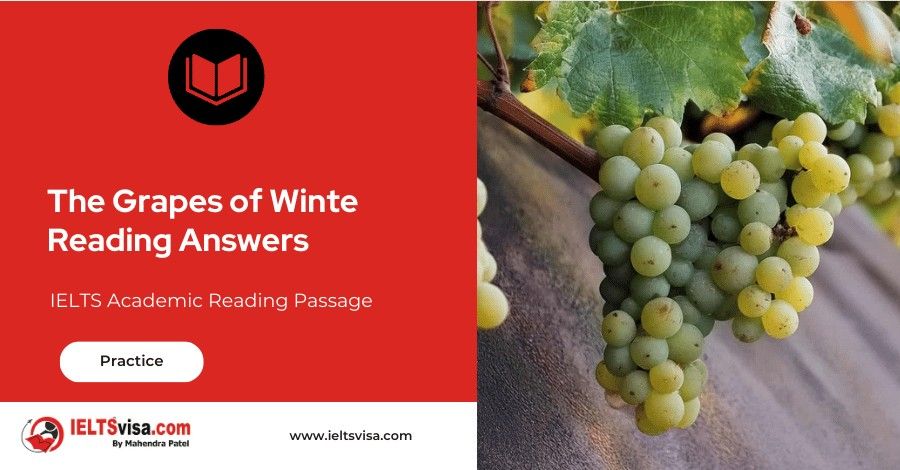The Grapes of Winte Reading Answers
IELTS Academic Reading Passage
A. Ice wine, or Eiswein as the Germans call it, is the product of frozen grapes. A small portion of the vineyard is left unpicked during the fall harvest those grapes arc left on the vine until the mercury drops to at least -7°C. At this temperature, the sugar-rich juice begins to freeze. If the grapes are picked in their frozen state and pressed while they are as hard as marbles, the small amount of juice recovered is intensely sweet and high in acidity. The amber dessert wine made from this juice is an ambrosia fit for Dionysus1 himself – very sweet, it combines savours of peach and apricot.
B. The discovery of ice wine, like most epicurean breakthroughs, was accidental. In 1794, wine producers in the German duchy of Franconia made virtue of necessity by pressing juice from frozen grapes. They were amazed by an abnormally high concentration of sugars and acids which, until then, had been achieved only by drying the grapes on straw mats before pressing or by the effects of Botrytis cinerea, a disease known as ‘root rot’. Botrytis cinerea afflicts grapes in autumn, usually in regions where there is early morning fog and humid, sunny afternoons. A mushroom-like fungus attaches itself to the berries, punctures their skins and allows the juice to evaporate. To many, the result is sheer ambrosia. The world’s great dessert wines, such as Sauternes, Riesling and Tokay Aszu Essencia, are made from grapes afflicted by this benign disease.
C. It was not until the mid-19th century in the Rheingau region of northwestern Germany that winegrowers made conscious efforts to produce ice wine on a regular basis. But they found they could not make it every year since the subzero cold spell must last several days to ensure that the berries remain frozen solid during picking and the pressing process, which alone can take up to three days or longer. Grapes are 80 percent water; when this water is frozen and driven off under pressure and shards of ice, the resulting juice is wonderfully sweet. If the ice melts during a sudden thaw, the sugar in each berry is diluted.
D. Not all grapes are suitable for ice wine. Only the thick-skinned, late-maturing varieties such as Riesling and Vidal can resist such predators as grey rot, powdery mildew, unseasonable warmth, wind, rain and the variety of fauna craving a sweet meal. Leaving grapes on the vine once they have ripened is an enormous gamble. If birds and animals do not get them, mildew and rot or a sudden storm might. So growers reserve only a small portion of their Vidal or Riesling grapes for ice wine, a couple of hectares of views at most.
E. To ensure the right temperature is maintained, in Germany the pickers must be out well before dawn to harvest the grapes. A vineyard left for ice wine is a sorry sight. The mesh-covered vines arc denuded of leaves and the grapes are brown and shriveled, dangling like tiny bats from the frozen canes. The stems of the grape clusters are dry and brittle. A strong wind or an ice storm could easily knock the fruit to the ground. A twist of the wrist is all that is needed to pick them, but when the wind howls through the vineyard, driving the snow- before it and the wind chill factor can make a temperature of -10° seem like -40°, harvesting ice wine grapes becomes a decidedly uncomfortable business. Pickers fortified with tea and brandy, brave the elements for two hours at a time before rushing back to the winery to warm up.
F. Once the tractor delivers the precious boxes of grapes to the winery, the really hard work begins. Since the berries must remain frozen, the pressing is done either outdoors or inside the winery with the doors left open. The presses have to be worked slowly otherwise the bunches will turn to a solid block of ice yielding nothing. Some producers throw rice husks into the press to pierce the skins of the grapes and create channels for the juice to flow- through the mass of ice. Sometimes it takes two or three hours before the first drop of juice appears.
G. A kilogram of unfrozen grapes normally produces sufficient juice to ferment into one bottle of wine. Depending on the degree of dehydration caused by wind and winter sunshine, the juice from a kilogram of ice wine grapes produces one-fifth of that amount or less. The longer the grapes hang on the vine, the less juice there is. So grapes harvested during a cold snap in December will yield more ice wine than if they are picked in February. The oily juice, once extracted from the marble-hard berries, is allowed to settle for three or four days. It is then clarified of dust and debris by ‘racking’ from one tank to another. A special yeast is added to activate fermentation in the stainless steel tanks since the colorless liquid is too cold to ferment on its own. Because of the high sugar content, the fermentation can take several months. But when the wine is finally bottled, it has the capacity to age for a decade or more.
H. While Germany may be recognized as the home of ice wine, its winemakers cannot produce it every year. Canadian winemakers can and are slowly becoming known for this expensive rarity as the home-grown product garners medals at international wine competitions. Klaus Reif of the Reif Winery at Niagara-on-the-Lake has produced ice wine in both countries. While studying oenology, the science of winemaking, he worked at a government winery in Neustadt in the West German state of Rheinland-Pfalz. In 1983 he made his first Canadian ice wine from Riesling grapes. Four years later he made ice wine from Vidal grapes grown in his uncle’s vineyard at Niagara-on-the-Lake. “The juice comes out like honey here” says Reif, “but in Germany it has the consistency of ordinary wine”.
Question 1-7:
Reading Passage 1 has seven paragraphs A-G
From the list of headings below, choose the most suitable heading for each paragraph.
Write the appropriate numbers i-x in boxes 1-7 on your answer sheet
List of Headings
- International comparisons
- Unique grapes withstand various attacks
- Production of initial juice
- Warm temperatures reduce sweetness
- Cold temperatures bring a sweet taste
- From grape to wine
- More grapes produce less wine
- Temperature vital to production
- Infection bring benefits
- Obstacles to picking
- The juice flows quickly
|
Example |
Answer |
|
Paragraph A |
V |
|
1) |
Paragraph B |
|
2) |
Paragraph C |
|
3) |
Paragraph D |
|
4) |
Paragraph E |
|
5) |
Paragraph F |
|
6) |
Paragraph G |
|
7) |
Paragraph H |
Question 8 – 10
Choose the correct letter A, B, C, or D
Write the answers in boxes 8 – 10 in the answer sheet.
8 Growers set aside only a small area for ice wine grapes because
A. not all grapes are suitable.
B. nature attacks them in various ways.
C. not many grapes are needed.
D. the area set aside makes the vineyard look extremely untidy.
9 Rice husks are used because they
A. stop the grapes from becoming ice blocks.
B. help the berries to remain frozen.
C. create holes in the grapes.
D. help producers create different tastes.
10 According to Klaus Reif, Canadian ice wine
A. flows more slowly than German wine.
B. tastes a lot like German ice wine.
C. is better than German ice wine.
D. is sweeter than German ice wine.
Question 11 – 14
Complete each of the following statements (from question 11 – 14) with the best ending A – G from the box below.
Write the appropriate letter A-G in boxes 11 – 14 on your answer sheet.
|
A |
Use diseased grapes to produce their wines |
|
B |
Enjoy working in cool climate |
|
C |
Can produce ice wine every year |
|
D |
Were surprised by the high sugar content in frozen grapes |
|
E |
Made a conscious effort to produce ice wine |
|
F |
Drink tea and brandy during their work |
11 Franconia ice winemakers
12 Famous dessert winemaker
13 Ice wine grape pickers in Germany
14 Canadian Ice Winemaker

Solution For: The Grapes of Winte
Reading Answers
| 1 IX | 2 VIII |
| 3 II | 4 X |
| 5 III | 6 VI |
| 7 I | 8 B |
| 9 C | 10 A |
| 11 D | 12 A |
| 13 F | 14 C |
Review and Practice
- Regularly practice with IELTS reading samples and time yourself to get used to the pressure of the exam.
- Review your mistakes to understand where you went wrong and how to avoid similar errors in the future.
Our Books
Master IELTS Speaking Part 1
IELTS Writing Task 1 Book
IELTS Writing Task 2 Book
The Grapes of Winte Reading Answers Explanation
Comin Soon
Practice IELTS Other Modules
IELTS Listening
The IELTS Listening test assesses how well you can understand spoken English in various contexts. It lasts about 30 minutes and is divided into four sections with a total of 40 questions. The listening tasks become increasingly difficult as the test progresses.
IELTS Academic Reading
The IELTS Academic Reading section assesses your ability to understand and interpret a variety of texts in academic settings. It is designed to evaluate a range of reading skills, including skimming for gist, reading for main ideas, reading for detail, understanding inferences, and recognizing a writer's opinions and arguments.
IELTS Speaking
The IELTS Speaking test assesses your ability to communicate in English on everyday topics. It lasts 11-14 minutes and consists of three parts: introduction, cue card, and a discussion based on the cue card topic.
IELTS General Reading
IELTS General Reading tests your ability to understand and interpret various types of texts. Here are some key areas and types of content you can expect to encounter in the reading section, along with tips for effective preparation.
IELTS Academic Writing Task 1
In IELTS Academic Writing Task 1, you are presented with a visual representation of information, such as graphs, charts, tables, or diagrams, and you are required to summarize, compare, or explain the data in your own words.
IELTS General Writing Task 1
In IELTS General Writing Task 1, you are required to write a letter based on a given situation. The letter can be formal, semi-formal, or informal, depending on the prompt. Here’s a breakdown of the key components to include in your letter
IELTS Academic Writing Task 2
In IELTS Academic Writing Task 2, you are required to write an essay in response to a question or topic. Here’s a guide to help you understand the essential elements of this task
IELTS Exam Tips
To succeed in the IELTS exam, practice regularly, familiarize yourself with the test format, improve your vocabulary, develop time management skills, and take mock tests to build confidence.
Grammer for IELTS
Grammar is the foundation of effective communication in English. Understanding tense usage, subject-verb agreement, and sentence structure enhances clarity and coherence in writing and speaking.
Vocabulary for IELTS
Vocabulary plays a crucial role in the IELTS (International English Language Testing System) exam, especially in the Speaking and Writing sections. Here’s an overview of why vocabulary is important and how it impacts your performance
RECENT IELTS SAMPLES QUESTIONS AND ANSWERS
Ditching that Saintly Image
A. Charities, it is still widely believed, are separate from the government, staffed entirely...
Sleep apnea
1. Sleep apnea is a common sleeping disorder. It affects a number of adults comparable to the...
A leap into history
A Between the Inishowen peninsula, north west of Derry, and the Glens of Antrim, in the east...
Caves
Caves are natural underground spaces commonly those into which man can enter. There are three...
Cure-all Pills: Myths or Reality?
Browse the shelves of any health food shop or pharmacy and you’ll find dozens of dietary...
Dawn Of The Robots
A. At first glance, it appeared to be a typical suburban road accident. A Land Rover...













